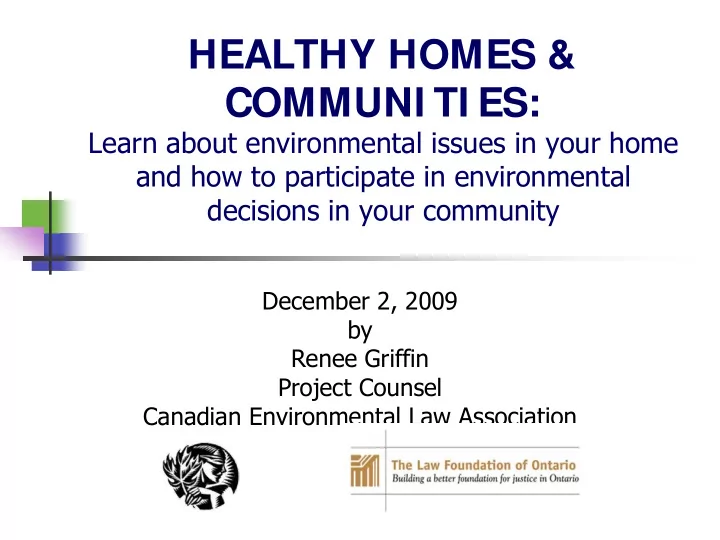

HEALTHY HOMES & COMMUNI TI ES: Learn about environmental issues in your home and how to participate in environmental decisions in your community December 2, 2009 by Renee Griffin Project Counsel Canadian Environmental Law Association
Introduction � This presentation is part of two greater initiatives by CELA – the “Making the Links” project and a province wide PLE outreach initiative. � Topics to be discussed today include: � Who is the Canadian Environmental Law Association (“CELA”)? How can we help you? � Link between pollution and poverty � Indoor air quality issues � Low income energy issues � Using the Environmental Bill of Rights � Using Pollution Watch
Introduction � This discussion is meant to help you understand: � Various environmental issues in your home � How to keep tabs on the situation in your local community � How to become involved in government decision making � Ways to keep government accountable for its decisions
Who is CELA? A non-profit, public interest group that uses existing laws to protect the � environment and to advocate environmental law reform. A legal aid clinic representing low-income citizens or citizens' groups in � environmental cases before courts and tribunals. CELA’s objectives: � To provide equitable access to justice to those otherwise unable to � afford representation for their environmental problems. To advocate for comprehensive laws, standards and policies that will � protect and enhance public health and environmental quality in Ontario and throughout Canada. To increase public participation in environmental decision-making. � To work with the public and public interest groups to foster long-term � sustainable solutions to environmental concerns and resource use. To prevent harm to human and ecosystem health through application � of precautionary measures.
How can CELA help you? � CELA can provide information, summary advice, and referrals. Intake calls are responded to by our articling student. � In some cases, CELA can provide formal legal opinions. CELA can also sometimes provide individual representation before courts, tribunals and other administrative bodies. � To apply to CELA contact our articling student at articling@cela.ca or call 416-960-2284, ext. 216
What is the “Making the Links” Project? � “Environmental Health, Equity, and Law: Making the Links” Project being undertaken by CELA and the Environmental Health Institute of Canada � Funded by the Law Foundation of Ontario � Goal: working with six communities throughout Ontario to increase capacity of, and knowledge-exchange between, residents, legal service providers, health service providers, and others interested in environmental health issues � Input and ideas welcome regarding environmental health issues of concern in the District of Kenora and ways in which we can be of use to the local community
Pollution and Poverty as Determinants of Health � Both living in poverty and exposure to high levels of pollution have been shown to be a major determinant of health in the Great Lakes Basin � See “An Examination of Pollution and Poverty in the Great Lakes Basin” (2008) at< http://pollutionwatch.org > � Low income families, and other vulnerable populations such as First Nations communities, pregnant women, the elderly, and young children are disproportionately exposed to and affected by environmental contaminants. These groups also often lack the legal and health information and services necessary to address their exposures and health outcomes.
Using the Environmental Bill of Rights (“EBR”) What is the EBR? � An important law that recognizes protection of the natural � environment as one of its primary purposes. It also provides mechanisms for you to participate in environmental decision making in your community. What does the EBR apply to? � The EBR applies to environmentally significant decisions and � proposals made by prescribed Ontario Ministries and under prescribed Acts. What does the EBR mean for me? � You can participate in � government decisions about the environment and hold the government accountable for those decisions
Shelter and the Environment: Indoor Air Quality Air (outdoor & indoor) is the most � significant media for environmental exposures Indoor air quality is a largely unregulated � source of such exposures According to the US EPA, indoor air � pollution is 1 of the top 5 environmental hazards to human health E.g.: home, work, schools, child care, � indoor recreational facilities Note: children spend approx. 80% of their � time indoors Photo: www.simpsonflint.com
Indoor Air Quality Contd. � Many concerns particularly associated with low-income and older housing � Indoor air contaminants of concern include: � environmental tobacco smoke; � inhalable particles form combustion products; � NO2; � VOCs; � lead; and � biological allergens (moulds, pet dander, house dust mites, etc.). � Contaminant levels in indoor dust
Indoor Air Quality Contd. � Practical tips for your home: � shoe removal; � floor cleaning; � hand washing; � smoke-free environments; � avoiding pesticides; � regular removal of house dust; � minimize carpeting or take precautionary steps with regard to it; and � choosing natural, untreated materials and other low-VOC products.
Shelter and the Environment: Drinking Water Sources � Lead can enter drinking water through: � lead service lines; � solder containing lead; brass fixtures; � � old lead supply lines; or � internal plumbing; containing lead pipes. � In Kenora, lead levels in distribution system are low � However, some homes built before the mid-1950s may still have lead service pipes
Drinking Water Sources Contd. � Tips: � flush water; � for older homes, find out if water supply pipes are made of lead; � use a filter that removes lead; and � let water stand for ≥ 15mins.
Recommend
More recommend